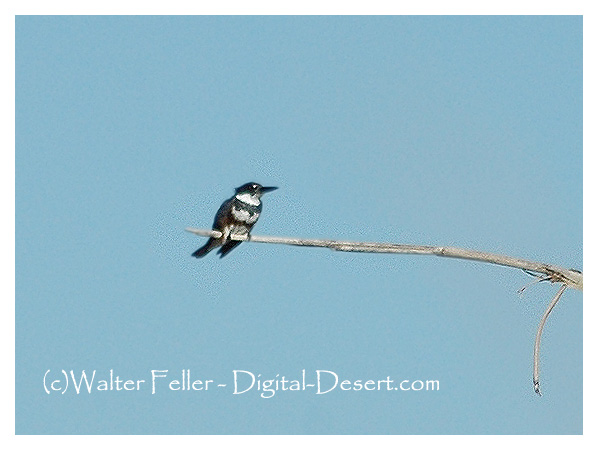Belted Kingfisher
Megaceryle alcyon
Family: ALCEDINIDAE
Order:
CORACIIFORMES
Class: AVES
DISTRIBUTION, ABUNDANCE, AND SEASONALITY
A rare to uncommon summer resident and common to abundant winter resident on bodies of water throughout the state. Valley foothill riparian and montane riparian habitats are preferred, but feeds in marine, estuarine, lacustrine, and riverine habitats as well. Rare breeder in southern coastal California and possibly in southern mountains. Along the southern coast and Colorado River, common in winter, but rare in deserts and mountains. In the north, uncommon in summer from the coast up to Jeffrey pine forests in mountain ranges. Common in winter on the coast and inland. There is a southward movement in winter and a downslope movement from mountain breeding areas. A regular migrant on the Farallon Islands (DeSante and Ainley 1980), and a nonbreeder on the Channel Islands year round (Garrett and Dunn 1981).
SPECIFIC HABITAT REQUIREMENTS
Feeding: Eats mostly fish; also amphibians, crayfish, and insects. Feeds insects to young initially, larger foods later. Hunts by diving into water from a perch or from hovering; prey usually captured less than .6 m (2 ft) from the surface.
Cover: Perches, and may roost at night, on dead branches or live trees near water (Terres 1980).
Reproduction: Usually excavates a nest burrow in a steep earthen bank of sandy, or otherwise friable, soil; sometimes in steep bank of gravel pit or landfill area; occasionally in tree or snag cavity. Nest usually near water, but can be up to 1.6 km (1 mi) away. Burrow usually within .6 m (2 ft) of top of bank, and more than 1.5 m (5 ft) above water or ground; generally 0.9 to 2 m (3-7 ft) deep (Airola 1980).
Water: Requires riparian and aquatic habitats. Prefers to perch over water to forage.
Pattern: All stages of growth along streams in wooded areas are used. Earthen banks nearby required for nesting. Preferred foraging areas have clear, slow moving, shallow water.
SPECIES LIFE HISTORY
Activity Patterns: Yearlong, diurnal activity.
Seasonal Movements/Migration: Resident within the state. Residents are joined by populations from the north, as indicated by an overall increase in abundance in winter, and by migrant status on Farallon Islands. Some upslope movement in late summer and fall after breeding at lower elevations in mountains, followed by a downslope movement from frozen waters in winter.
Home Range: Cornwell (1963) found foraging home range usually within 1.6 km (1 mi) of nest, but occasionally up to 8 km (5 mi).
Territory: Salyer and Lagler (1946) reported territory averaging .8 km (0.5 mi), and varying up to 2.4 km (1.5 mi), of shoreline along the Great Lakes. They found territory along forested rivers averaging longer than along lake shores: 2.4 to 4.8 km (1.5 to 3 mi). Cornwell (1963) found 14 pairs in 65 km˛ (25 mi˛), averaging 1 pair per 4.6 km˛ (1.8 mi˛) in Michigan lakes and streams. Foraging perch in territory is defended.
Reproduction: Breeds from April to mid-August with peak activity in May and June. Pair nests solitarily. Lays 5-14 eggs (usually 6-8); incubated by both parents for 23-24 days. One brood raised per season; a damaged clutch may be replaced in new burrow. Young altricial; eyes open at about 2 wk, and leave burrow in 30-35 days. Young tended by both parents (Harrison 1978).
Niche: Eggs and young preyed upon by mammals and snakes. Adults sometimes taken by hawks.
REFERENCES
Airola, D. A., ed. 1980. California wildlife habitat relationships program: Northeast Interior Zone. Vol III. Birds. U.S. Dep. Agric., For. Serv., Lassen Natl. For., Susanville. 590pp. Cornwell, G. W. 1963. Observation on the breeding biology and behavior of a nesting population of belted kingfishers. Condor 65:426-431. DeSante, D. F., and D. G. Ainley. 1980. The avifauna of the South Farallon Islands, California. Studies in Avian Biol. No. 4. Cooper Ornithol. Soc., Lawrence, KA. 104pp. Garrett, K., and J. Dunn. 1981. Birds of southern California. Los Angeles Audubon Soc. 408pp. Harrison, C. 1978. A field guide to the nests, eggs and nestlings of north American birds. W. Collins Sons and Co., Cleveland, OH. 416pp. Salyer, J. C., II, and K. F. Lagler. 1946. The eastern belted kingfisher, Megaceryle alcyon alcyon (Linneaus), in relation to fish management. Trans. Am. Fish. Soc. 76:97-117.
Terres, J. K. 1980. The Audubon Society encyclopedia of North American birds. A. Knopf, New York. 1100pp.44. The distribution of the birds of California. Pac. Coast Avifauna No. 27. 608pp.
B293
Life history accounts for species in the California Wildlife Habitat Relationships (CWHR) System were originally published in: Zeiner, D.C., W.F.Laudenslayer, Jr., K.E. Mayer, and M. White, eds. 1988-1990. California's Wildlife. Vol. I-III. California Depart. of Fish and Game, Sacramento, California. Updates are noted in accounts that have been added or edited since original publication. Written by: M. Green
Reviewed by: L. Mewaldt
Edited by: R. Duke, D. Winkler
Megaceryle alcyon
It is 28–36 cm long, with deep blue or bluish-gray plumage with white markings, a shaggy crest and a broad white collar around the neck.
It is often seen perched prominently on trees, posts, or other suitable watchpoints close to water before plunging in head first after its fish prey. They also eat small crustaceans, frogs, aquatic insects, small mammals, lizards and berries. These birds often give a rattling call as they fly overhead.
300-birds